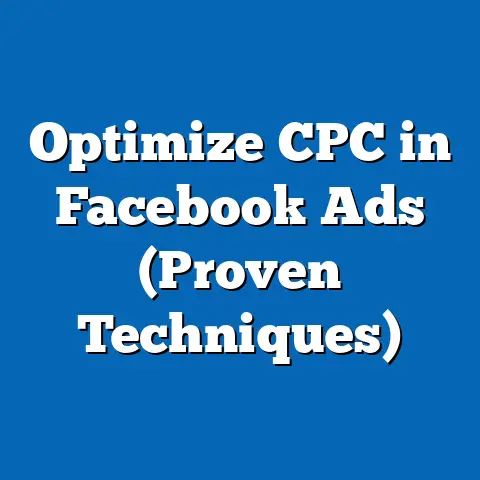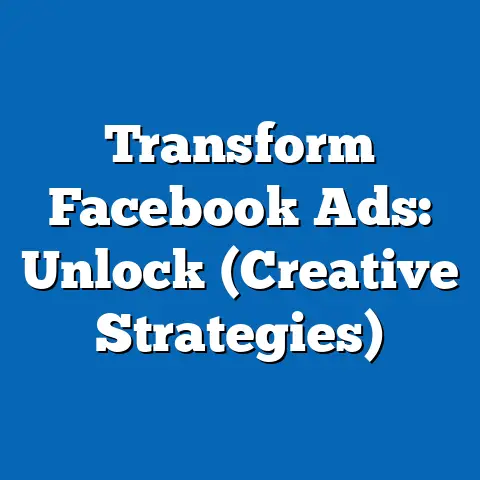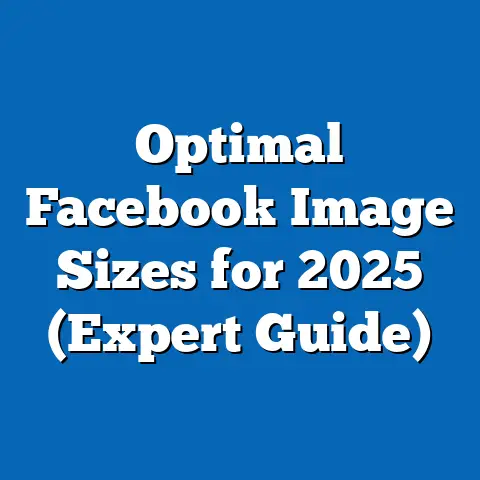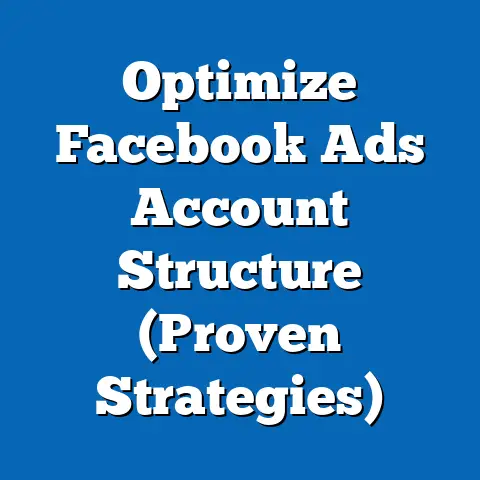Adjusting Facebook Ad Budgets Effectively (Smart Strategies)
Adjusting Facebook Ad Budgets Effectively: Smart Strategies for Maximizing Value
In the rapidly evolving landscape of digital marketing, Facebook advertising remains a cornerstone for businesses seeking to reach targeted audiences with precision and scale. As one of the largest social media platforms, with over 2.9 billion monthly active users as of 2023 (Statista, 2023), Facebook offers unparalleled opportunities for brands to connect with diverse demographics across the globe. However, the effectiveness of a Facebook ad campaign hinges not just on creative content or audience targeting, but significantly on how budgets are allocated and adjusted over time.
Understanding Value in Facebook Advertising
Value in the context of Facebook advertising is not merely about minimizing costs or maximizing clicks; it is about achieving the highest return on investment (ROI) by aligning budget allocation with campaign goals, audience behavior, and platform dynamics. A well-adjusted budget ensures that every dollar spent contributes to measurable outcomes—whether that’s brand awareness, lead generation, or direct sales. Key defining characteristics of value-driven budgeting include flexibility, data responsiveness, and strategic alignment with broader marketing objectives.
Historically, digital advertising emerged as a cost-effective alternative to traditional media in the early 2000s, with platforms like Google AdWords paving the way for pay-per-click (PPC) models. Facebook entered the scene with its advertising platform in 2007, initially offering basic ad formats like sidebar banners. Over the years, as user data became more granular and algorithms more sophisticated, the platform evolved into a powerhouse for targeted advertising, necessitating more nuanced budget strategies to keep pace with rising competition and ad costs.
The societal implications of effective budget management on Facebook are profound. On one hand, optimized budgets enable small businesses and startups to compete with larger corporations by leveraging precise targeting and cost-efficient scaling. On the other hand, the increasing reliance on algorithmic budget adjustments raises ethical questions about data privacy, ad fatigue among consumers, and the potential for manipulative marketing practices. As digital ad spend continues to grow—projected to reach $740 billion globally by 2025 (eMarketer, 2023)—understanding how to maximize value while navigating these societal concerns is critical for marketers.
Historical Context: The Evolution of Digital Ad Budgeting
To fully grasp the importance of adjusting Facebook ad budgets effectively, it’s essential to trace the historical trajectory of digital advertising and budgeting practices. In the early days of online ads, budgets were often static, with marketers setting fixed amounts for banner ads or email campaigns without real-time performance data. The introduction of PPC models by Google in 2000 revolutionized budget allocation by tying costs directly to user engagement, prompting a shift toward dynamic spending based on results.
Facebook’s entry into advertising in 2007 marked a turning point, as it combined social data with ad delivery, allowing for unprecedented targeting precision. Initially, budgets were managed manually, with advertisers setting daily or lifetime caps based on intuition rather than analytics. The launch of Facebook’s Ads Manager in 2011, followed by automated bidding options in 2014, shifted the paradigm toward data-driven budgeting, where algorithms could optimize spend in real time based on campaign performance.
Significant events, such as the 2018 Cambridge Analytica scandal, also shaped budgeting strategies by highlighting the risks of over-reliance on user data, leading to stricter privacy regulations like GDPR in Europe. These regulations increased ad costs as targeting became less granular, forcing marketers to adopt smarter budget adjustments to maintain ROI. Today, with tools like Campaign Budget Optimization (CBO) and machine learning-driven insights, budget management on Facebook is a blend of human strategy and algorithmic precision—a balance that continues to evolve with technological advancements.
Key Characteristics of Effective Budget Adjustment
Adjusting Facebook ad budgets effectively requires a deep understanding of several core principles that define successful strategies. First, flexibility is paramount; budgets must be adaptable to real-time performance metrics such as click-through rates (CTR), cost per acquisition (CPA), and return on ad spend (ROAS). For instance, if an ad set targeting a specific demographic underperforms, reallocating budget to a higher-performing segment can maximize results without increasing overall spend.
Second, data-driven decision-making underpins effective adjustments. Marketers must leverage tools like Facebook Insights and third-party analytics platforms to monitor key performance indicators (KPIs) and identify trends. A 2022 study by Hootsuite found that campaigns with regular budget adjustments based on data analysis achieved 25% higher ROAS compared to static budgets.
Third, alignment with campaign objectives ensures that budget adjustments serve the overarching goal, whether it’s driving traffic, generating leads, or boosting sales. For example, a brand awareness campaign may prioritize impressions over clicks, necessitating a budget skewed toward broader audience reach rather than conversion-focused ad sets. These characteristics highlight the need for a strategic, rather than reactive, approach to budget management, ensuring that every adjustment adds measurable value.
Smart Strategies for Adjusting Facebook Ad Budgets
With the foundational principles in place, let’s explore specific strategies for adjusting Facebook ad budgets effectively. These strategies are designed to balance cost efficiency with performance optimization, catering to businesses of all sizes and industries.
1. Start with a Testing Phase and Incremental Scaling
Before committing to a large budget, initiate campaigns with a testing phase to identify high-performing ad creatives, audiences, and placements. Allocate a small budget—typically 10-20% of the total planned spend—across multiple ad sets with varying targeting parameters. For instance, test different age groups, interests, or geographic regions to determine which segments yield the best results.
Once data from the testing phase is collected (usually over 3-7 days), scale the budget incrementally by reallocating funds to top-performing ad sets while pausing or reducing spend on underperforming ones. This approach minimizes risk and ensures that budget increases are backed by evidence of success. A 2021 report by Social Media Today found that campaigns using a testing-to-scaling model achieved a 30% lower CPA compared to those with static budgets.
2. Leverage Campaign Budget Optimization (CBO)
Facebook’s Campaign Budget Optimization tool allows advertisers to set a single budget at the campaign level, with the platform automatically distributing funds to the best-performing ad sets. This strategy is particularly effective for campaigns with multiple ad sets targeting diverse audiences, as it reduces manual oversight and relies on Facebook’s algorithm to optimize for results.
To use CBO effectively, ensure that each ad set has sufficient data (at least 50 conversions per week) to inform the algorithm’s decisions. Additionally, monitor performance regularly to avoid over-allocating budget to a single ad set at the expense of others with potential for growth. According to a 2023 study by AdEspresso, campaigns using CBO saw a 15-20% improvement in cost efficiency compared to manual budget allocation.
3. Adjust Budgets Based on Audience Fatigue and Frequency
Ad fatigue—when audiences see the same ad too often—can lead to declining engagement and higher costs. Monitor frequency metrics in Facebook Ads Manager; a frequency above 3-5 (meaning an individual sees the ad more than three to five times) often signals the need for creative refresh or budget reallocation to new audiences.
If fatigue is detected, consider reducing spend on overexposed ad sets and redirecting funds to fresh audiences or new ad variations. Alternatively, use dynamic creative optimization (DCO) to automatically rotate ad elements like headlines and images, maintaining engagement without increasing budget. This strategy ensures sustained value by preventing wasted spend on disengaged users.
4. Utilize Dayparting and Seasonal Adjustments
Consumer behavior varies by time of day, day of the week, and season, necessitating budget adjustments to align with peak engagement periods. Dayparting—allocating more budget to specific hours or days—can be informed by historical data in Ads Manager, showing when your audience is most active. For example, a B2C retailer might increase spend on evenings and weekends when users are more likely to browse social media.
Seasonal adjustments are equally critical, especially for industries with cyclical demand, such as retail during holiday seasons or travel during summer. A 2022 analysis by eMarketer revealed that campaigns with seasonal budget spikes during high-demand periods achieved 35% higher conversion rates. Planning ahead for these fluctuations ensures that budgets are maximized during windows of opportunity.
5. Implement Automated Rules for Real-Time Adjustments
Facebook’s automated rules allow marketers to set predefined conditions for budget adjustments, such as increasing spend if CPA falls below a certain threshold or pausing ad sets if costs exceed a set limit. These rules enable real-time optimization without constant manual intervention, saving time while maintaining performance.
For instance, a rule might increase budget by 20% for ad sets with a ROAS above 3.0, ensuring that high-performing segments receive adequate funding. However, automated rules should be paired with regular human oversight to account for contextual factors that algorithms may overlook, such as emerging trends or competitor activity.
6. Balance Long-Term and Short-Term Goals
While short-term performance metrics like daily clicks or conversions are important, effective budget adjustments should also consider long-term objectives like brand equity and customer lifetime value (CLV). Allocate a portion of the budget to top-of-funnel activities—such as video ads for awareness—even if immediate ROI is lower, as these efforts build a foundation for future conversions.
A balanced approach might involve a 70-20-10 budget split: 70% on high-ROI conversion campaigns, 20% on engagement and retargeting, and 10% on experimental or awareness-focused ads. This strategy ensures sustained growth by addressing both immediate revenue needs and long-term brand building.
Technological, Economic, Social, and Cultural Influences on Budget Strategies
Adjusting Facebook ad budgets does not occur in a vacuum; it is influenced by a range of external factors that shape how marketers allocate resources. Technologically, advancements in machine learning and AI have transformed budget optimization by enabling predictive analytics and automated bidding. Tools like Facebook’s Advantage+ campaigns, introduced in 2022, use AI to streamline budget distribution across placements, reducing manual effort while improving outcomes.
Economically, rising ad costs—driven by increased competition and privacy regulations—require smarter budget adjustments to maintain profitability. For instance, the implementation of Apple’s App Tracking Transparency (ATT) framework in 2021 reduced the effectiveness of iOS targeting, leading to a reported $10 billion loss in ad revenue for Meta (Forbes, 2022). Marketers must now allocate budgets more strategically to offset these challenges, often focusing on broader interest-based targeting or first-party data.
Socially, consumer expectations for personalized, non-intrusive ads influence budget strategies. Over-targeting or high-frequency ads can alienate users, necessitating careful budget allocation to avoid negative brand sentiment. Culturally, global differences in social media usage and purchasing behavior require localized budget adjustments; for example, a campaign targeting Gen Z in the U.S. might prioritize Instagram Stories, while one in Asia may focus on WhatsApp integration.
These factors underscore the complexity of budget management, highlighting the need for a nuanced approach that accounts for both platform-specific dynamics and broader societal trends.
Societal and Workplace Implications
The implications of effective Facebook ad budget adjustments extend beyond individual campaigns to influence broader societal and workplace dynamics. For society, optimized budgets democratize advertising by enabling small businesses to reach niche audiences affordably, fostering entrepreneurship and economic diversity. However, the reliance on algorithmic optimization raises concerns about transparency and fairness, as smaller advertisers may struggle to compete with larger budgets that “train” algorithms faster.
In the workplace, the shift toward data-driven budget strategies has created demand for skilled digital marketers proficient in analytics and automation tools. According to LinkedIn’s 2023 Jobs Report, roles like “Digital Marketing Specialist” and “Data Analyst” are among the fastest-growing professions, reflecting the need for expertise in budget optimization. At the same time, the pressure to deliver high ROI can contribute to workplace stress, necessitating a balance between performance goals and employee well-being.
Culturally, the pervasive nature of targeted ads—enabled by precise budget allocation—shapes consumer behavior by influencing purchasing decisions and lifestyle trends. While this can drive economic growth, it also risks perpetuating consumerism or reinforcing biases if budgets disproportionately target certain demographics. Marketers must navigate these implications responsibly, ensuring that budget strategies align with ethical standards.
Comparing Generational Responses to Budget-Optimized Ads
Generational differences play a significant role in how budget-optimized ads are received, necessitating tailored strategies. Baby Boomers (born 1946-1964), often less tech-savvy, respond better to straightforward ads with clear calls-to-action, requiring budgets focused on desktop placements and simple messaging. Gen X (born 1965-1980), a bridge between analog and digital, values authenticity and may engage more with ads tied to nostalgia or practical benefits, influencing budget allocation toward content-driven campaigns.
Millennials (born 1981-1996), as digital natives, prioritize value and social impact, often responding to ads with strong storytelling or user-generated content. Budgets targeting this group might emphasize video ads or influencer partnerships. Gen Z (born 1997-2012), with shorter attention spans and high social media usage, demands dynamic, visually engaging ads on mobile-first formats like Stories or Reels, requiring frequent budget adjustments to keep pace with trends.
While these generational tendencies provide guidance, it’s critical to avoid stereotypes and recognize individual diversity within cohorts. A data-driven approach—adjusting budgets based on real-time engagement metrics—ensures that campaigns resonate across age groups without relying on assumptions.
Challenges and Nuances in Budget Adjustment
Despite the benefits of smart budget strategies, several challenges complicate effective adjustment. One major hurdle is the unpredictability of platform algorithm updates, which can alter ad delivery and costs overnight. For instance, Meta’s 2023 focus on Reels as a priority format shifted budget effectiveness toward short-form video, catching many advertisers off guard.
Additionally, the diversity of business goals and audience behaviors introduces variability in budget outcomes. A strategy that works for a local retailer may fail for a global e-commerce brand, highlighting the need for customized approaches. Smaller businesses, often constrained by limited budgets, face the added challenge of competing with larger advertisers who can afford to “test” at scale.
These nuances underscore the importance of continuous learning and adaptation. Marketers must stay informed about platform changes, invest in training, and leverage A/B testing to refine budget strategies over time. Acknowledging these challenges prevents overconfidence in any single approach, fostering a mindset of experimentation and resilience.
Forward-Looking Insights and Uncertainties
Looking ahead, the landscape of Facebook ad budget adjustment is poised for further transformation driven by emerging technologies and shifting consumer expectations. The integration of augmented reality (AR) and virtual reality (VR) into ads—part of Meta’s metaverse vision—may require new budget models to account for immersive formats. Similarly, advancements in AI could enable hyper-personalized budget optimization, though privacy regulations may limit data availability.
Economic uncertainties, such as inflation or recessionary pressures, could also influence ad budgets, with businesses prioritizing cost efficiency over experimental campaigns. Societally, growing awareness of digital well-being may push consumers to demand less intrusive ads, necessitating budget shifts toward organic content or less aggressive retargeting.
While these trends offer exciting possibilities, uncertainties remain. Will privacy laws further restrict targeting capabilities, increasing ad costs? How will generational shifts, such as Gen Alpha’s entry into the consumer market, reshape budget priorities? Marketers must approach the future with flexibility, balancing innovation with ethical considerations to ensure sustainable value.
Conclusion
Adjusting Facebook ad budgets effectively is both an art and a science, requiring a blend of strategic planning, data analysis, and adaptability to platform and societal changes. By focusing on value—through flexible, data-driven, and goal-aligned strategies—marketers can maximize ROI while navigating the complexities of digital advertising. Historical context reveals how far budget practices have come, from static allocations to AI-powered optimization, while current trends highlight the interplay of technological, economic, and cultural factors.
The societal implications of optimized budgets are vast, influencing economic equity, workplace dynamics, and consumer culture. As generational differences and ethical concerns shape ad reception, marketers must remain vigilant, adjusting budgets not just for performance but for long-term impact. Looking forward, while uncertainties abound, a commitment to continuous learning and responsible practices will ensure that budget strategies evolve in step with the digital landscape.
Ultimately, smart budget adjustment on Facebook is about more than numbers; it’s about creating meaningful connections between brands and audiences in a way that delivers value for all stakeholders. By embracing the strategies and insights outlined here, businesses can position themselves for success in an ever-changing advertising ecosystem.






